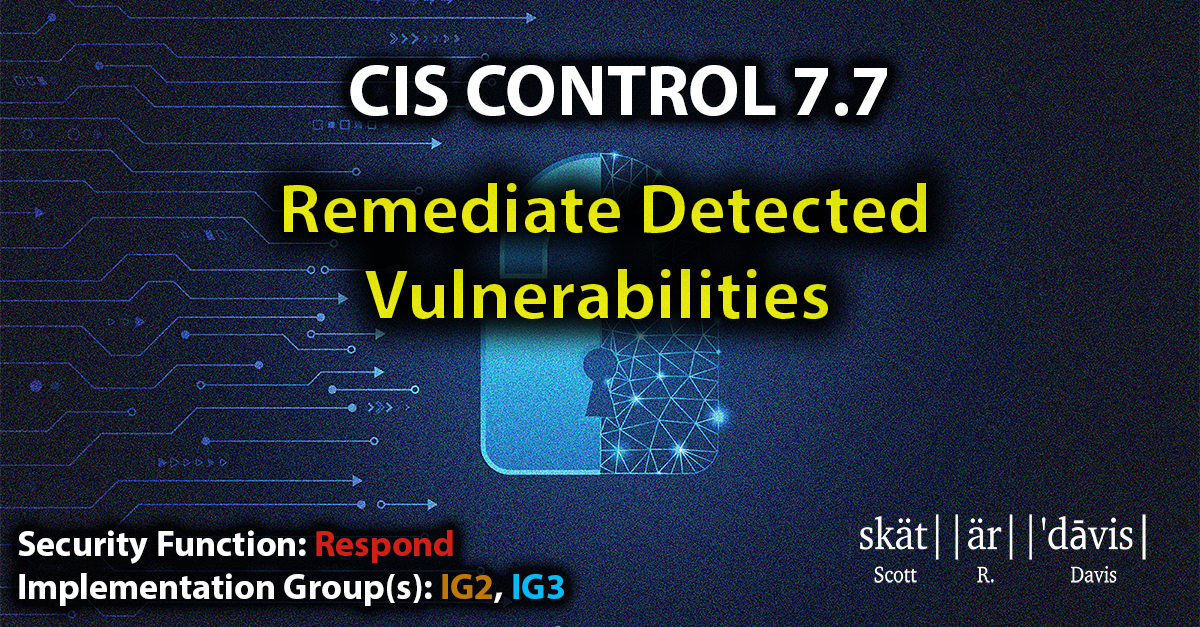
The Center for Internet Security (CIS) Controls emphasize not just identifying vulnerabilities but also addressing them promptly. Control 7.7 focuses on remediating detected vulnerabilities in software to reduce risk and maintain a strong security posture.
This safeguard requires organizations to act on identified vulnerabilities through defined processes and tools.
Here’s how to implement this:
- Remediation Process: Leverage your documented remediation strategy (see CIS Control 7.2) to prioritize and address vulnerabilities based on their risk level.
- Tooling: Use vulnerability management tools to track and manage remediation efforts efficiently. Many tools also provide guidance on resolving specific vulnerabilities.
- Regular Cadence: Address vulnerabilities on a monthly basis or more frequently for critical or high-risk issues. The goal is to close security gaps as quickly as possible.
Why is this important? Detecting vulnerabilities is only half the battle—remediation is where risk reduction happens. Regular, timely remediation ensures vulnerabilities are addressed before they can be exploited, helping you stay ahead of attackers.
To recap, CIS Control 7.7 ensures your organization remediates detected vulnerabilities through a structured process, leveraging tools to resolve issues promptly and maintain a secure environment.
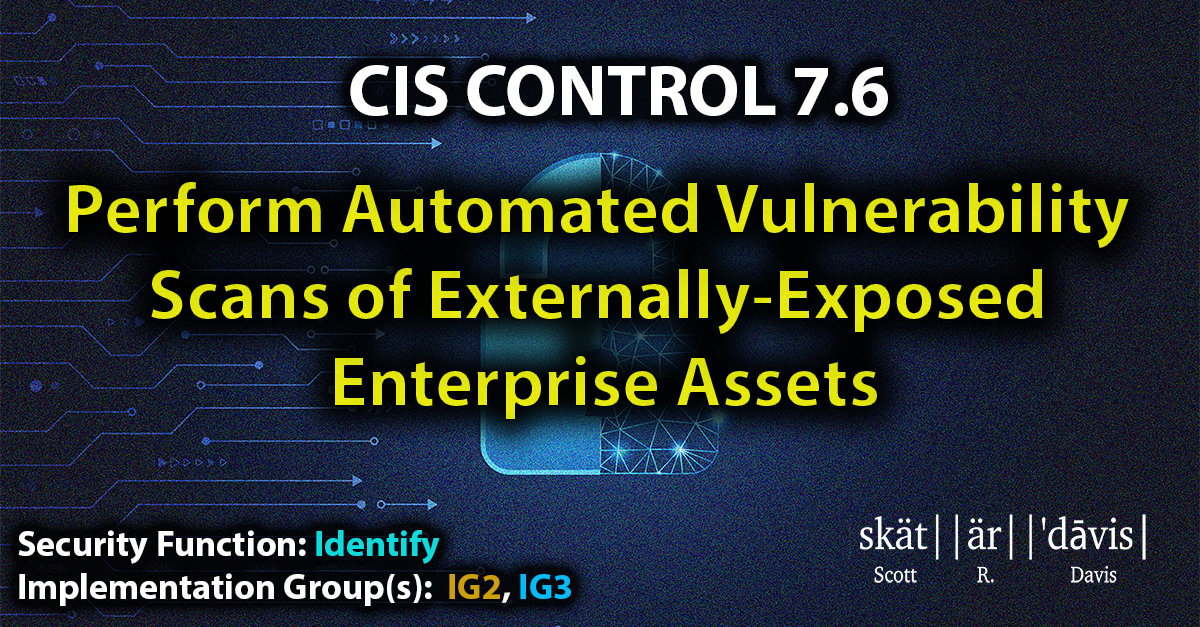
The Center for Internet Security (CIS) Controls prioritize identifying vulnerabilities before they can be exploited, and Control 7.6 focuses on externally-exposed enterprise assets. This safeguard ensures organizations regularly scan and assess the security of assets exposed to the public internet.
Here’s what this entails:
- Automated Scanning: Use automated tools to identify vulnerabilities in systems exposed externally, such as web servers, VPNs, email servers, and cloud-hosted services.
- SCAP-Compliant Tools: Select a Security Content Automation Protocol (SCAP)-compliant vulnerability scanning tool to ensure standardized and accurate results.
- Regular Cadence: Perform scans monthly or more frequently, depending on the sensitivity and importance of the assets. External systems are high-value targets for attackers, so frequent scans are critical.
Why is this important? Externally-exposed assets are the most accessible to attackers and are often the first point of entry in a cyberattack. Regular, automated scans help identify vulnerabilities early, allowing you to address them before they can be exploited.
To recap, CIS Control 7.6 ensures your organization conducts automated vulnerability scans of externally-facing assets on a regular basis, safeguarding your perimeter and reducing the risk of external attacks.
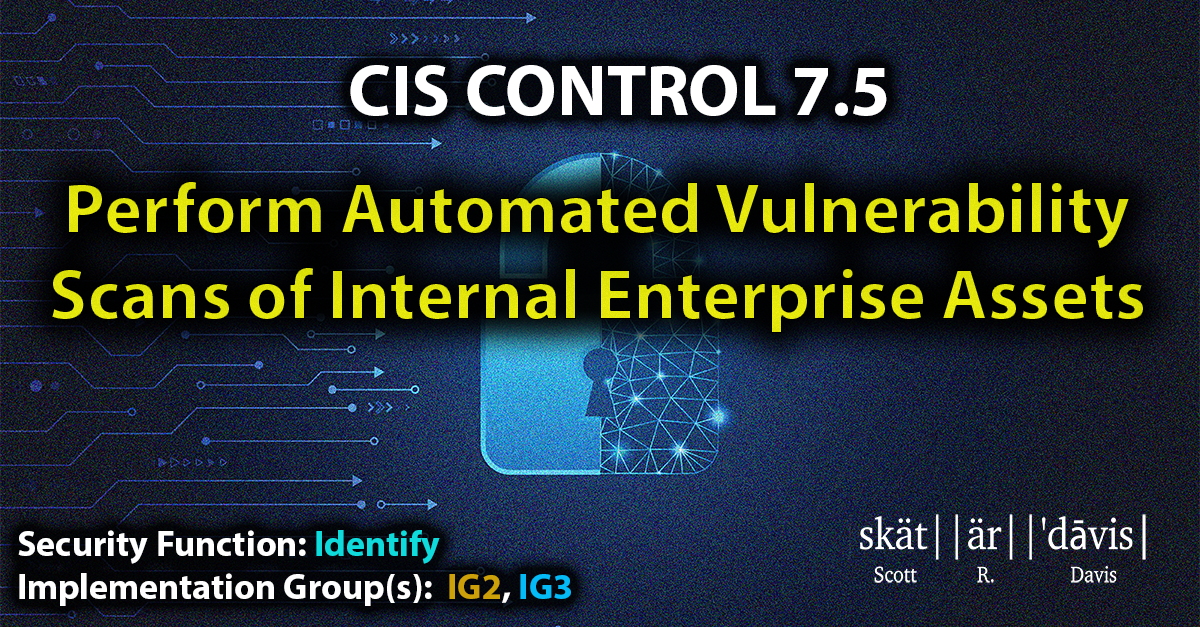
The Center for Internet Security (CIS) Controls emphasize identifying vulnerabilities before attackers can exploit them. Control 7.5 ensures organizations perform automated vulnerability scans on internal enterprise assets regularly.
This safeguard requires organizations to conduct both authenticated and unauthenticated scans using a SCAP-compliant vulnerability scanning tool.
Here’s how to implement this:
- Automated Scanning: Schedule automated vulnerability scans of all internal systems, including servers, workstations, and network devices.
- Authenticated vs. Unauthenticated Scans:
- Authenticated scans use valid credentials to identify vulnerabilities that are only visible with access, providing deeper insights.
- Unauthenticated scans simulate an external attacker’s perspective, identifying vulnerabilities visible without access.
- Regular Cadence: Perform scans quarterly or more frequently based on the criticality of the assets and the evolving threat landscape.
- SCAP-Compliant Tools: Use tools that comply with the Security Content Automation Protocol (SCAP) to ensure consistent and standardized reporting.
Why is this important? Vulnerability scans identify weaknesses in your systems before attackers can exploit them. Conducting both authenticated and unauthenticated scans provides a comprehensive view of your security posture.
To recap, CIS Control 7.5 ensures your organization performs regular, automated vulnerability scans of internal assets, helping to identify and address security gaps proactively.
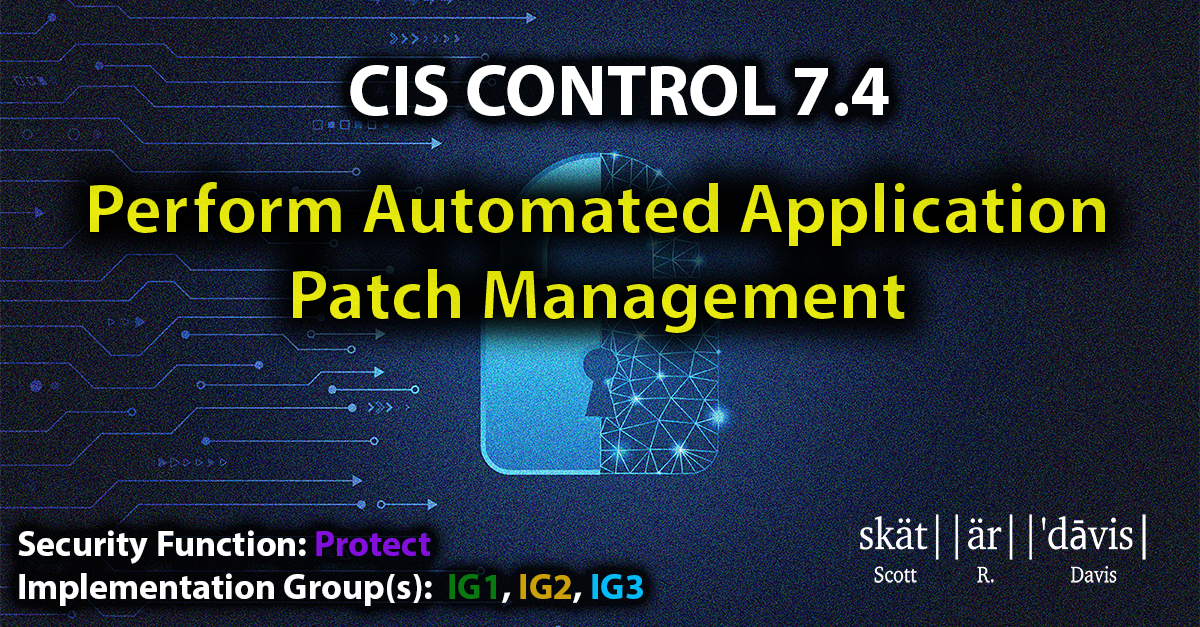
The Center for Internet Security (CIS) Controls emphasize staying proactive against vulnerabilities, and Control 7.4 focuses on automating application patch management to secure enterprise assets.
This safeguard requires organizations to automate the process of applying updates to applications on a regular schedule.
Here’s how to implement this:
- Automated Updates: Use tools like Microsoft Endpoint Manager, patch management platforms, or native application update mechanisms to automatically apply updates and fixes for all software.
- Regular Cadence: Schedule patches monthly or more frequently for critical updates addressing high-risk vulnerabilities. Timely updates ensure your applications stay secure and stable.
- Enterprise Assets: Include all enterprise software—business-critical apps, productivity tools, and custom-developed software—to ensure comprehensive coverage.
Why is this important? Unpatched applications are a common target for attackers, as they often contain exploitable vulnerabilities. Automating the patch process reduces manual effort, eliminates delays, and ensures consistent protection across your environment.
To recap, CIS Control 7.4 ensures your organization uses automated processes to keep applications up to date, reducing the risk of exploitation and maintaining a strong security posture.
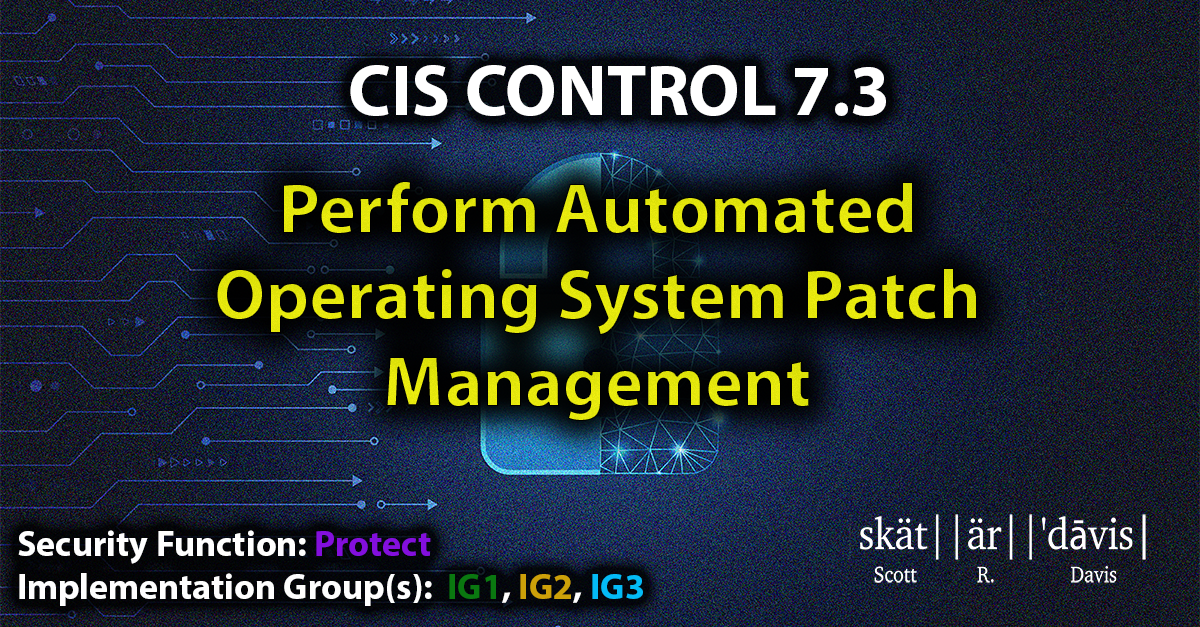
The Center for Internet Security (CIS) Controls emphasize the importance of keeping systems updated, and Control 7.3 focuses on automating operating system patch management to protect enterprise assets.
This safeguard requires organizations to automate the process of applying updates to operating systems on a regular schedule.
Here’s how to implement this:
- Automated Updates: Use tools like Microsoft Windows Server Update Services (WSUS), Linux package managers, or third-party solutions to automate patch deployment. This minimizes manual effort and ensures consistency. This is also an area where tools designed for Managed Services Providers known as RMM (Remote Monitoring and Management) that provide management of OS patching.
- Regular Cadence: Apply patches monthly or more frequently, especially for critical updates addressing known vulnerabilities. Timely updates help close security gaps before they can be exploited.
- Enterprise Assets: This applies to all systems, including servers, workstations, and any other devices running operating systems within your environment.
Why is this important? Outdated operating systems are a common entry point for attackers. Automating patch management reduces the likelihood of missing updates, helping you maintain a secure and compliant environment.
To recap, CIS Control 7.3 ensures your organization leverages automation to keep operating systems up to date, protecting enterprise assets from known vulnerabilities and reducing the risk of exploitation.
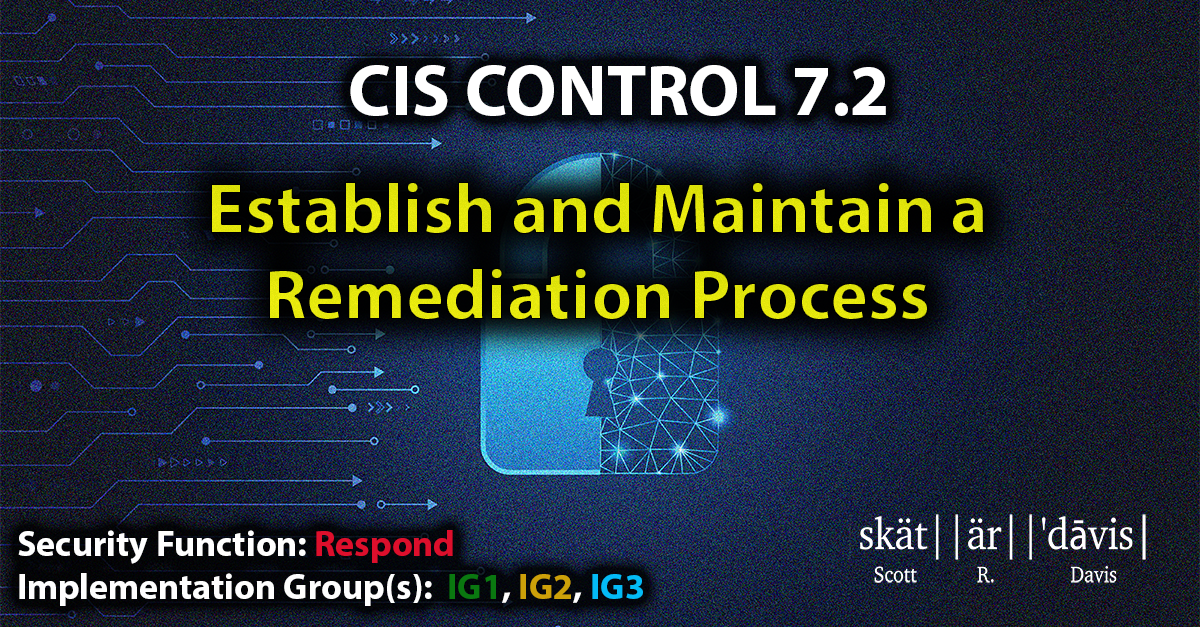
The Center for Internet Security (CIS) Controls emphasize responding effectively to vulnerabilities, and Control 7.2 focuses on creating a documented remediation process to address identified risks systematically.
This safeguard requires organizations to establish and maintain a risk-based remediation strategy that is reviewed regularly.
Here’s what this looks like:
- Document the Strategy: Create a detailed plan outlining how vulnerabilities will be prioritized and remediated based on risk. High-risk vulnerabilities should be addressed first, with clear timelines for remediation.
- Regular Reviews: Review and update the remediation process at least monthly or more frequently, depending on the volume and severity of vulnerabilities identified. This ensures the strategy remains aligned with your current risk environment.
- Risk-Based Approach: Not all vulnerabilities are created equal. Focus resources on addressing those that pose the greatest risk to your organization while maintaining a plan for lower-priority issues.
Why is this important? A well-defined remediation process ensures vulnerabilities are addressed consistently and efficiently, minimizing the window of opportunity for attackers to exploit weaknesses. Regular reviews keep your strategy relevant as your systems and the threat landscape evolve.
To recap, CIS Control 7.2 ensures your organization has a structured, risk-based approach to remediating vulnerabilities, with regular reviews to stay ahead of emerging threats and maintain a strong security posture.
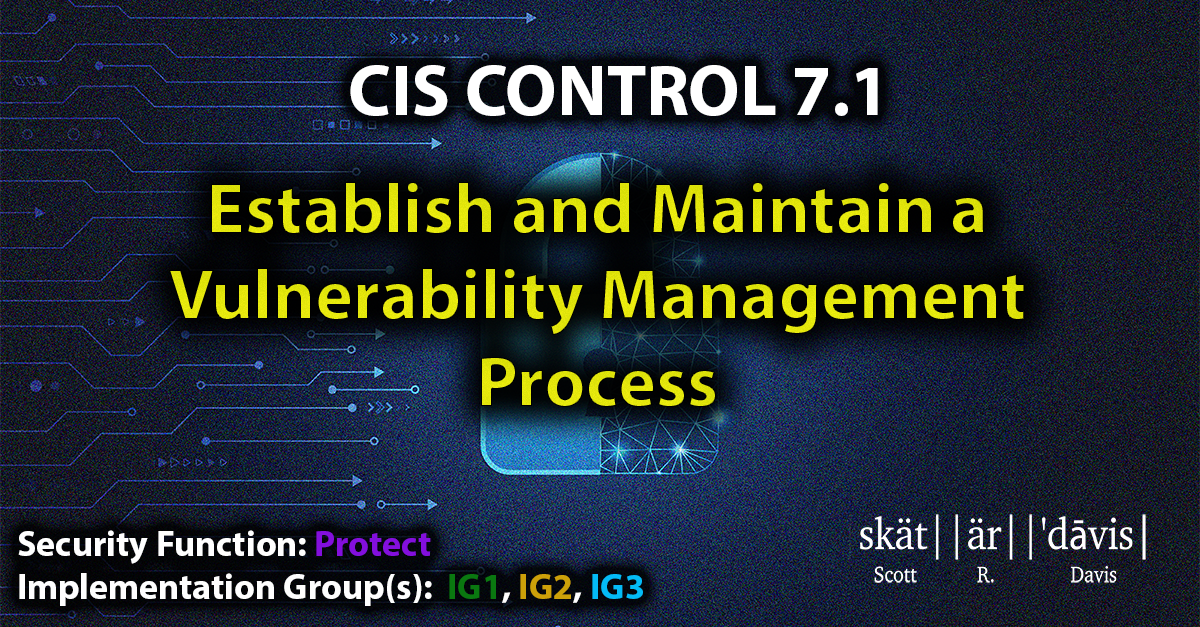
The Center for Internet Security (CIS) Controls emphasize proactive measures to reduce risks, and Control 7.1 focuses on creating a documented vulnerability management process to safeguard your enterprise assets.
This safeguard requires organizations to establish and maintain a formal process for identifying, assessing, and addressing vulnerabilities in their systems.
Here’s what this looks like:
- Document the Process: Clearly outline how your organization identifies vulnerabilities, prioritizes them, and mitigates the associated risks. This documentation serves as a roadmap for your vulnerability management efforts.
- Review and Update: The process isn’t static. Review and update it at least annually or whenever significant changes occur, such as deploying new systems, adopting new technologies, or restructuring your IT environment.
- What It Covers: Include all enterprise assets—servers, workstations, applications, and third-party systems.
Why is this important? Vulnerabilities are often exploited by attackers to gain unauthorized access or disrupt operations. A documented process ensures a consistent, repeatable approach to identifying and addressing these weaknesses before they can be exploited.
To recap, CIS Control 7.1 ensures that your organization has a well-defined and regularly updated vulnerability management process, helping you stay ahead of potential threats and maintain a strong security posture.
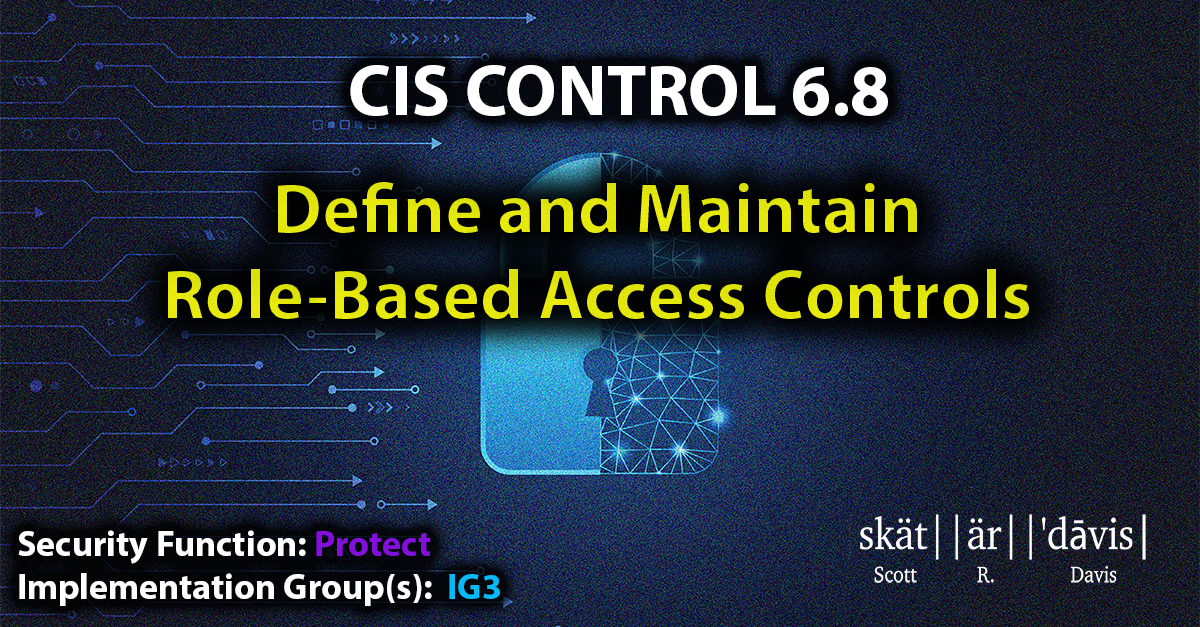
The Center for Internet Security (CIS) Controls emphasize effective management of user privileges, and Control 6.8 is all about implementing Role-Based Access Control (RBAC) to ensure users only have the access they need.
This safeguard involves defining, documenting, and maintaining access rights based on specific roles within your organization.
Here’s how it works:
- Define Roles: Identify the roles within your organization (e.g., HR Manager, IT Administrator, Sales Associate) and the access each role requires to perform its duties effectively.
- Document Access Rights: Clearly outline what systems, data, or tools each role can access. This documentation acts as your blueprint for granting and auditing permissions.
- Regular Reviews: Access control isn’t “set it and forget it.” Perform reviews of all enterprise assets to ensure that privileges are still authorized. At a minimum, this should happen annually, but more frequent reviews may be necessary based on organizational changes.
Why is this important? Role-Based Access Control minimizes the risk of privilege creep (when users accumulate excessive access over time) and reduces the potential for insider threats. It ensures that employees have the access they need—no more, no less—to perform their duties securely.
To recap, CIS Control 6.8 ensures your organization defines and enforces RBAC policies, reviews them regularly, and validates that all access privileges are authorized. This safeguard is key to maintaining strong access control and protecting your enterprise data.
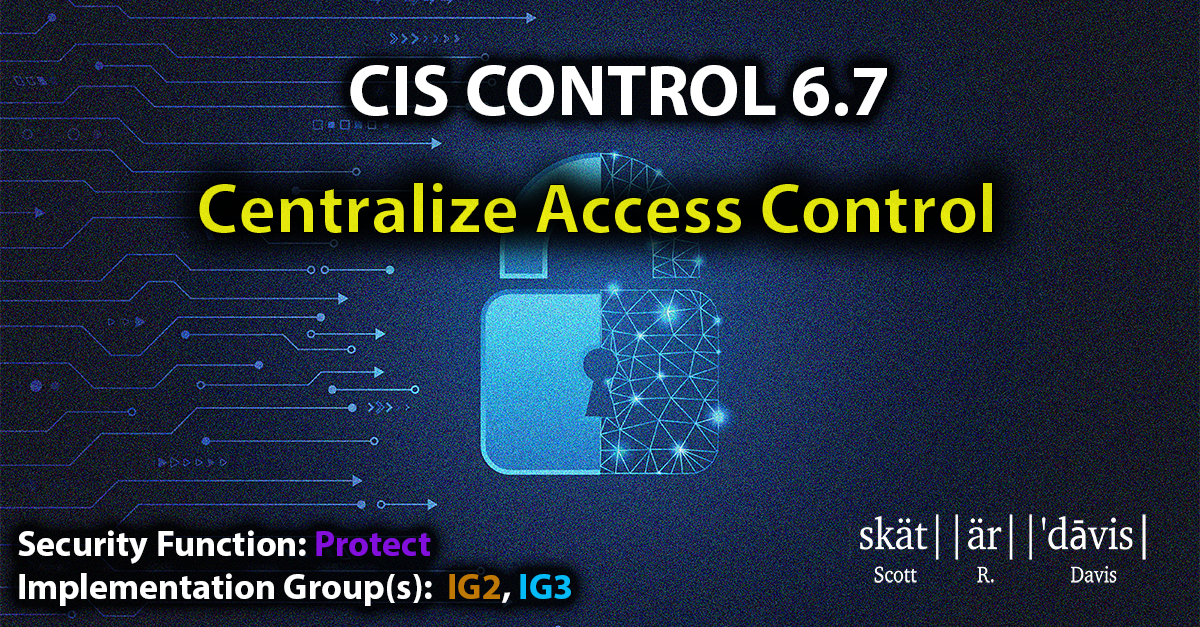
The Center for Internet Security (CIS) Controls continue to emphasize the importance of simplifying and securing access management, and Control 6.7 focuses on centralizing access control for all enterprise assets.
This safeguard is straightforward: use a directory service or Single Sign-On (SSO) provider to centralize access control wherever it’s supported.
Here’s what this looks like:
- Centralized Access Control: By consolidating access management into one system, you simplify user authentication and authorization processes. This can reduce errors, improve security, and make auditing easier.
- Directory Services and SSO Providers: Tools like Microsoft Active Directory (on-premises or Azure AD), Okta, or similar platforms allow you to manage access to applications, devices, and data from one central point.
- Why Centralization Matters: Without a centralized approach, organizations often rely on siloed or manual processes, increasing the risk of inconsistent access policies, misconfigurations, and potential breaches.
Why is this important? A centralized system not only improves efficiency but also strengthens security. It ensures consistent application of access policies across your entire enterprise, making it easier to implement features like Multi-Factor Authentication (MFA) and Role-Based Access Control (RBAC).
To recap, CIS Control 6.7 ensures that access control is centralized through a directory service or SSO provider. This safeguard helps simplify management, improve security, and ensure your organization remains protected as it grows.





